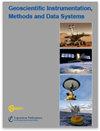ACES-II 低探空火箭上的原型魔方磁通门磁力计的首次现场测量
IF 2.3
4区 地球科学
Q3 GEOSCIENCES, MULTIDISCIPLINARY
Geoscientific Instrumentation Methods and Data Systems
Pub Date : 2024-01-25
DOI:10.5194/egusphere-2024-189
引用次数: 0
摘要
摘要。下一代磁通门磁强计的不断创新对于未来开展空间等离子体研究,特别是磁层和太阳风中能量传输的多航天器实验研究非常重要。展示新型设计的空间飞行能力是仪器开发过程中的重要一步;然而,大型卫星任务往往不愿意接受没有飞行经验的仪器所带来的风险。Tesseract是一种新型磁通门磁力计传感器设计,它有机会在2022年11月从挪威安德尔斯的安多亚航天中心发射的ACES-II探空火箭任务中进行首次太空飞行演示。魔方 "的设计利用了新的赛道核心几何形状来制造传感器,从而解决了导致传统环形核心设计不稳定的一些问题。在此,我们将介绍基于新型魔方传感器的磁通门磁力计原型的设计、飞行前特性以及对其在 ACES-II 上飞行性能的评估。我们发现,Tesseract 在飞行过程中测得的磁场与 ACES II 机载参考环形核心磁通门磁力计和地磁场模型的预测结果非常一致。在穿越活跃极光弧时,基于魔方的磁力计测量到了场对齐电流和潜在阿尔弗韦恩波活动的特征,我们认为它的表现符合预期。作为目前计划于 2025 年发射的 MAGIC 技术演示的一部分,Tesseract 将搭载 TRACERS 小型探索者(SMEX)卫星任务。本文章由计算机程序翻译,如有差异,请以英文原文为准。
First In Situ Measurements of the Prototype Tesseract Fluxgate Magnetometer on the ACES-II Low Sounding Rocket
Abstract. Ongoing innovation in next generation fluxgate magnetometry is important for enabling future investigations of space plasma, especially multi-spacecraft experimental studies of energy transport in the magnetosphere and the solar wind. Demonstrating the spaceflight capability of novel designs is an important step in the instrument development process; however, large-scale satellite missions are often unwilling to accept the risks of an instrument without flight heritage. The Tesseract – a novel fluxgate magnetometer sensor design-had an opportunity for an inaugural spaceflight demonstration on the ACES-II sounding rocket mission, which launched from Andøya Space Center in Andenes, Norway, in November 2022. Tesseract’s design takes advantage of a new racetrack core geometry to create a sensor that addresses some of the issues that contribute to instability in more traditional ring core designs. Here we present the design of a prototype fluxgate magnetometer based on the new Tesseract sensor, its preflight characteristics, and an evaluation of its inflight performance aboard ACES-II. We find that the magnetic field measured by Tesseract over the course of the flight was in strong agreement with both the onboard ACES II reference ring core fluxgate magnetometer and the predictions of a geomagnetic field model. The Tesseract based magnetometer measured signatures of field aligned currents and potential Alfvén wave activity as it crossed an active auroral arc, we conclude that it performed as expected. Tesseract will be flown on the TRACERS Small Explorers (SMEX) satellite mission as part of the MAGIC technology demonstration currently scheduled to launch in 2025.
求助全文
通过发布文献求助,成功后即可免费获取论文全文。
去求助
来源期刊

Geoscientific Instrumentation Methods and Data Systems
GEOSCIENCES, MULTIDISCIPLINARYMETEOROLOGY-METEOROLOGY & ATMOSPHERIC SCIENCES
CiteScore
3.70
自引率
0.00%
发文量
23
审稿时长
37 weeks
期刊介绍:
Geoscientific Instrumentation, Methods and Data Systems (GI) is an open-access interdisciplinary electronic journal for swift publication of original articles and short communications in the area of geoscientific instruments. It covers three main areas: (i) atmospheric and geospace sciences, (ii) earth science, and (iii) ocean science. A unique feature of the journal is the emphasis on synergy between science and technology that facilitates advances in GI. These advances include but are not limited to the following:
concepts, design, and description of instrumentation and data systems;
retrieval techniques of scientific products from measurements;
calibration and data quality assessment;
uncertainty in measurements;
newly developed and planned research platforms and community instrumentation capabilities;
major national and international field campaigns and observational research programs;
new observational strategies to address societal needs in areas such as monitoring climate change and preventing natural disasters;
networking of instruments for enhancing high temporal and spatial resolution of observations.
GI has an innovative two-stage publication process involving the scientific discussion forum Geoscientific Instrumentation, Methods and Data Systems Discussions (GID), which has been designed to do the following:
foster scientific discussion;
maximize the effectiveness and transparency of scientific quality assurance;
enable rapid publication;
make scientific publications freely accessible.
 求助内容:
求助内容: 应助结果提醒方式:
应助结果提醒方式:


